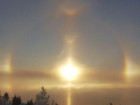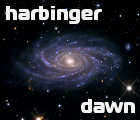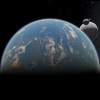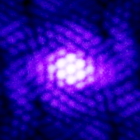|
Planetary Impacts
|
|
| midtskogen | Date: Wednesday, 06.03.2013, 13:40 | Message # 46 |
 Star Engineer
Group: Users
 Norway
Norway
Messages: 1674
Status: Offline
| I agree with most. However, if the rovers are several thousand km away from the impact, I think they will survive the 12-13 magnitude quake, though it would cause ground movement of several meters, because these surface waves peak to peak would be many kilometres, tens and up to a few hundred km at such distances. There would also be seismic waves hitting sooner, which have travelled through Mars. These waves would be shorter, causing more rapid shaking, but the movement is much less, and perhaps as for Earth, the outer core could absorb them if the rovers are in the shadow zone. There would be avalanches, cracks, and several ways the rovers could be destroyed by such a quake reaching the most violent phase within an hour after impact, and it could go on for at least an hour, nowhere would be safe, but at this stage survival is quite plausible. The atmospheric blast would come next, but the rovers could still be standing because of the thin air. But then I think all luck would be spent. They will be covered in dust if not hit by solid debris.
Whether there would be enough dust in the inner solar system to absorb sunlight is an interesting thought. Is it really plausible?
However, I would be surprised if the nucleus really is 50 km. Few comets are that big. One could perhaps argue that it ought to be big since it was discovered early. But at this distance what they see would be the coma (which develops earlier than the tails), not the nucleus?
NIL DIFFICILE VOLENTI

|
| |
| |
| HarbingerDawn | Date: Wednesday, 06.03.2013, 20:28 | Message # 47 |
 Cosmic Curator
Group: Administrators
 United States
United States
Messages: 8717
Status: Offline
| Quote (midtskogen) However, I would be surprised if the nucleus really is 50 km. Few comets are that big.
Few, but some are, so it's possible. Anyway, it's at the upper end of the range of estimates. But even if it were closer in size to Hale-Bopp (>30 km) it would still cause colossal damage.
Quote (midtskogen) Is it really plausible?
I'm curious about this as well.
Quote (midtskogen) But at this distance what they see would be the coma (which develops earlier than the tails), not the nucleus?
Well of course, though it's not impossible to see both. The hard part about estimating comet sizes is that it's not often easy to determine just how much light is directly reflected from the nucleus, and how much comes from ejected material. Only if a comet is very large and/or close can its size be easily determined (also is easier if it ejects very little material).
All forum users, please read this!
My SE mods and addons
Phenom II X6 1090T 3.2 GHz, 16 GB DDR3 RAM, GTX 970 3584 MB VRAM
|
| |
| |
| midtskogen | Date: Wednesday, 06.03.2013, 22:38 | Message # 48 |
 Star Engineer
Group: Users
 Norway
Norway
Messages: 1674
Status: Offline
| Quote (HarbingerDawn) I'm curious about this as well.
First, the dust must overcome Mars' escape velocity which is 5 km/s. Second, the dust must get inside Earth's orbit. Third, the dust must settle in the ecliptic. Since Mars is close to the ecliptic, the last point sounds plausible. And that's where we find most of the existing interplanetary dust, suggesting that it tends to settle there.
I suppose something like this would need many years to happen. And if it does, it sounds more like a trigger for an ice age than a comet winter.
But considering the many comets that irregularly pass near the sun and break up, which apparently doesn't affect the climate [and satellites should detect tiny fluctuations in the sun's irradiance corrected for distance and sunspots], could an incident at Mars, outside our orbit, really make a difference, even if 10 or 100 times more of Mars than the comet's original mass is thrown into space, and some of it towards the sun?
NIL DIFFICILE VOLENTI

Edited by midtskogen - Wednesday, 06.03.2013, 22:49 |
| |
| |
| HarbingerDawn | Date: Wednesday, 06.03.2013, 23:00 | Message # 49 |
 Cosmic Curator
Group: Administrators
 United States
United States
Messages: 8717
Status: Offline
| Quote (midtskogen) it sounds more like a trigger for an ice age than a comet winter.
I'm thinking that he meant the term "comet winter" to have the same sort of meaning as "nuclear winter".
Quote (midtskogen) First, the dust must overcome Mars' escape velocity which is 5 km/s
Not hard given how much material would probably also reach that velocity.
Quote (midtskogen) Second, the dust must get inside Earth's orbit.
Might depend on the side of Mars that's impacted. If it's facing retrograde then this is plausible.
Quote (midtskogen) Third, the dust must settle in the ecliptic.
Obviously it would.
If this whole dust thing happened the way Vladimir described, though, just imagine how the zodiacal light would look! 
All forum users, please read this!
My SE mods and addons
Phenom II X6 1090T 3.2 GHz, 16 GB DDR3 RAM, GTX 970 3584 MB VRAM
|
| |
| |
| midtskogen | Date: Thursday, 07.03.2013, 07:19 | Message # 50 |
 Star Engineer
Group: Users
 Norway
Norway
Messages: 1674
Status: Offline
| Quote (HarbingerDawn) I'm thinking that he meant the term "comet winter" to have the same sort of meaning as "nuclear winter".
I understood that, but a nuclear winter would only last up to a few years.
Quote (HarbingerDawn) If this whole dust thing happened the way Vladimir described, though, just imagine how the zodiacal light would look!
Yes, it would be fascinating for a little while, then astronomers would curse it. Like the aurora. Exotic for those who never or rarely have seen it, a nuisance if you need to do serious work involving observation of the sky. 
EDIT: Speaking of which. I haven't seen zodiacal light explicitly mentioned in Vladimir's TODO list. I can imagine it could be stronger in other systems than what we have, if there are many comets. Perhaps it depends on the strength of the solar wind as well.
NIL DIFFICILE VOLENTI

Edited by midtskogen - Thursday, 07.03.2013, 08:01 |
| |
| |
| SpaceEngineer | Date: Thursday, 07.03.2013, 17:58 | Message # 51 |
 Author of Space Engine
Group: Administrators
 Russian Federation
Russian Federation
Messages: 4800
Status: Offline
| If comet have 5+ km in diameter, debris and dust of impact would certainly escape martian gravity. Some of them, which have right velosity, will turn around Mars and fly away in the direction, opposite to the impact site. So theoretically, debris will spread in all directions.

|
| |
| |
| Watsisname | Date: Thursday, 07.03.2013, 21:36 | Message # 52 |
 Galaxy Architect
Group: Global Moderators
 United States
United States
Messages: 2613
Status: Offline
| The particles ejected retrograde would have smaller semi-major axes and therefore orbit the Sun more rapidly, so they outpace Mars and spread ahead of it in its orbit. Particles ejected prograde have larger orbits and end up lagging Mars, and of course there would be a large range of debris in-between. Due to the range of different orbital periods, particles would spread across the entire orbital space, given enough time. This same process may be seen in the spread of comet dust along their orbits, or the formation of a debris ring around Earth after the Iridium/Kosmos satellite collision in 2009.
As for a global comet winter, I understand it would be a few 105 or even 106 cubic kilometers of material ejected, much of which would have greater than escape velocity from Mars, but would the optical depth of that material spread through the inner solar system really be high enough to affect solar insolation at Earth?

|
| |
| |
| SpaceEngineer | Date: Thursday, 07.03.2013, 21:47 | Message # 53 |
 Author of Space Engine
Group: Administrators
 Russian Federation
Russian Federation
Messages: 4800
Status: Offline
| Even 10% drop in solar insolation may trigger an ice age. Maybe a "snowball Earth" may be explained as a result of collision of a huge body with Mars or Mercury in the past.

|
| |
| |
| HarbingerDawn | Date: Thursday, 07.03.2013, 21:57 | Message # 54 |
 Cosmic Curator
Group: Administrators
 United States
United States
Messages: 8717
Status: Offline
| Quote (SpaceEngineer) Even 10% drop in solar insolation may trigger an ice age.
I find a 10% drop to be highly implausible from a collision with Mars. Only if 100% of the dust were crowded between Earth and Sun (which is impossible) would it cause a significant effect; at least, that's the way I see it, but I certainly can't back that up with math or precedent.
All forum users, please read this!
My SE mods and addons
Phenom II X6 1090T 3.2 GHz, 16 GB DDR3 RAM, GTX 970 3584 MB VRAM
|
| |
| |
| midtskogen | Date: Thursday, 07.03.2013, 22:18 | Message # 55 |
 Star Engineer
Group: Users
 Norway
Norway
Messages: 1674
Status: Offline
| My main objection against the possibility of a comet winter is that we can probably detect changes in insolation due to changes in interplanetary dust that are smaller than 0.1%, and then why don't we hear about such changes due to sun grazing and dissolving comets? Considering the current climate frenzy, surely someone would notice that in the data if there were changes?
But then again, a 50 km object hitting one of the inner planets is an extremely rare event and therefore it's hard to say what exactly to expect. It probably only happens a few times every 100 million years. It sounds like a problem well fit for simulation.
NIL DIFFICILE VOLENTI

|
| |
| |
| Watsisname | Date: Thursday, 07.03.2013, 23:53 | Message # 56 |
 Galaxy Architect
Group: Global Moderators
 United States
United States
Messages: 2613
Status: Offline
| The amount of material shed from a sun-diving comet is far smaller than that which would be ejected into space if this comet impacts Mars, so I don't see a problem there. Rather, I have trouble imagining that even the latter case would have much optical depth. 10% in this context is massive! Even a 0.1% reduction would surprise me.
I think I just need (and would love) to see the math done on this. Perhaps I could manage it if I made a number of simplifying assumptions. I'll look into it. 

Edited by Watsisname - Thursday, 07.03.2013, 23:56 |
| |
| |
| HarbingerDawn | Date: Friday, 08.03.2013, 00:26 | Message # 57 |
 Cosmic Curator
Group: Administrators
 United States
United States
Messages: 8717
Status: Offline
| Quote (Watsisname) 10% in this context is massive! Even a 0.1% reduction would surprise me.
Agreed
Quote (Watsisname) I think I just need (and would love) to see the math done on this.
Agreed again! 
All forum users, please read this!
My SE mods and addons
Phenom II X6 1090T 3.2 GHz, 16 GB DDR3 RAM, GTX 970 3584 MB VRAM
|
| |
| |
| Watsisname | Date: Friday, 08.03.2013, 03:43 | Message # 58 |
 Galaxy Architect
Group: Global Moderators
 United States
United States
Messages: 2613
Status: Offline
| Okay, here's a very simple cocktail napkin type calculation. Don't take any of these numbers too seriously; I just thought this may help give some intuition.
We'll calculate the optical depth of the dust by examining the Earth-Sun system as a cylinder with the Sun on one side as a uniform light source, the Earth as the other, and the space between filled with dust grains of uniform size.
Then the volume of the cylinder is the length times its cross sectional area,
The number of grains in the cylinder is equal to the number density times the volume,
The optical depth (tau), or the fraction of light blocked by grains, is then given by the total cross section of the grains divided by the cross section of the cylinder, which simplifies to the number density of grains times their cross sectional area times the length of the cylinder. I'll write this in symbols later to be more clear. Now:
-Assume the hypothetical impact on Mars ejects a volume of material Vej.
-Assume (incorrectly) that all this material is in the form of grains with uniform radius rg.
-Assume (very incorrectly) that all this material ends up in a disk between the Earth and Sun (distance = a = 1AU) with uniform density and height h.
Then the number of grains produced is the volume ejected divided by the volume of a grain:

Divide by the volume of the region of the disk to get their number density n:

And the cross section of a grain is simply:

And we may now compute the optical depth τ:


If we assume 106 km3 of material ejected (remember to multiply by 109 to convert to meters cubed), a uniform grain size of one millimeter, and a disk thickness equal to the Earth's diameter, then we get an optical depth of 0.12. That's pretty high! But that's also being exceedingly generous regarding the fraction of the grains that get within Earth orbit. I also only assumed a disk thickness of ~12000km. In reality it would be much more dispersed, thus decreasing the number density.
Of course, I also made a very big assumption on the size of the particles -- I gave them a radius of 1 millimeter. If the average size is much smaller, then the optical depth is increased.
Anyway, feel free to play around with numbers, share what you all think, and please feel free to correct my math if I made any mistakes. 
edit: whoops, did find a couple mistakes. Corrected.
Edit 2: I thought about this a bit more. Since each of these factors is linear, different choices of inputs have a big effect on the outcome. Here's a different (and I think more believable) scenario:
Let 10^6 km^3 of material be ejected, assume half of it is in the form of dust, half of that actually escapes mars, 10% again of that ends up within Earth orbit, and the fraction of orbital time one for which those particles is within Earth orbit is 1/4. Assume average particle size is much smaller (one micron), and the disk thickness is much greater at a million kilometers. Then the optical depth in this case is 0.01, which is still much greater than I would have originally guessed. (This would mean ~1% of the light gets blocked). So perhaps you are right, SpaceEngineer. 

Edited by Watsisname - Friday, 08.03.2013, 05:05 |
| |
| |
| SpaceEngineer | Date: Friday, 08.03.2013, 13:30 | Message # 59 |
 Author of Space Engine
Group: Administrators
 Russian Federation
Russian Federation
Messages: 4800
Status: Offline
| Quote (midtskogen) My main objection against the possibility of a comet winter is that we can probably detect changes in insolation due to changes in interplanetary dust that are smaller than 0.1%, and then why don't we hear about such changes due to sun grazing and dissolving comets?
Because comets have very little amount of dust, ~1%, all other matter is volatiles (water, ammonia, methane). But here we talking about cloud of dust ejected from martian surface by comet impact.

|
| |
| |
| SpaceEngineer | Date: Friday, 08.03.2013, 13:44 | Message # 60 |
 Author of Space Engine
Group: Administrators
 Russian Federation
Russian Federation
Messages: 4800
Status: Offline
| Watsisname, to be more precise, you should use the expected distribution of debris/dust particles sizes (usually, exponential), and the theory of light scattering. And makeing some assumption about the shape of debris cloud (ring) and its evolution over time (light pressure, Poynting–Robertson effect, and gravity influence of the planets will scatter the cloud). But your simple calculation shows that effect of a "comet winter" is possible.

|
| |
| |